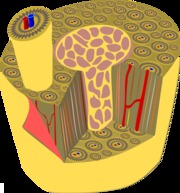What is the cause of any particular case of osteoporosis? This can be maddening, but there is no answer to that question. Osteoporosis is multifactorial.
Medical experts speak in terms of "risk factors" for osteoporosis (and indeed for many diseases. If you have one of these risk factors, you are at a greater risk for osteoporosis, but there is no guarantee the disease will develop. And the converse is also true: people with many risk factors will not necessarily see a substantial drop in bone density.
Risk factors can be divided into ones that you cannot control and ones that you have some influence on.
Age – the older you get, the more susceptible you are to osteoporosis, which is a progressive disease. Your bone density declines before you get to the point of osteoporosis proper. Women experience an increase in risk after menopause.
Sex – Women are more likely to get osteoporosis, although men can get it too.
Low body weight/petite frame
Heredity – dd.
Health problems including hormone abnormalities Cushing's disease and hyperparathyroidism (too much parathyroid hormone) and trouble digesting food and absorbing nutrients (Crohn's disease, celiac disease) are risk factors, too. Thyroid abnormalities leading to hyperthyroidism and hypothyroidism (too much and too little hormone) are risk factors. Renal disease and rheumatoid arthritis substantially increase the risk of hip and vertebral fractures.
Genetic diseases that increase the risk include: Gaucher’s disease, Cystic fibrosis, Hypophosphatasia, Marfan syndrome, Menkes steely hair syndrome, Hemochromatosis, Homocystinuria, and Glycogen storage diseases.
Paralysis of limbs substantially increases the risk as those bones are not stressed. Many wheelchair-bound people get osteoporosis in their femurs. Think of this as an extreme case of a sedentary lifestyle – low activity and exercise puts one at risk.
Scientists have also found the level of C-reactive protein in the bloodstream is a predictor of bone fracture. Even a small increase in the protein level is associated with increased risk.
Alcohol, and even caffeine consumption increase the risk of osteoporosis. The effect of caffeine is weak, but it has been documented. Caffeine consumption increases the risk for osteoporosis, apparently by slowing the spread of osteoblast cells. Chinese researchers have hypothesized that is is actually the bone marrow-derived mesenchymal stem cells (BMSCs) - which are the predecessors to the osteoblasts - that are more sensitive to caffeine. Alcohol has some health benefits in moderation, but it also has systemic effects and increases rates of many diseases. However, a recent study at Oregon State University suggests that very moderate alcohol consumption may slow the rate of bone turnover and reduce fracture risk in women.
Smoking - see here.
Eating disorders like bulimia and anorexia increase the risk just by reducing the amount of nutrients entering the bloodstream.
Never having a baby (for women).
Diet is a minor risk factor, possibly. The effects of diet on otherwise healthy people as to their risk of developing osteoporosis is not clear. Really low calcium intake over a period of years seems to play a part. Deficiency in the childhood and adolescent years are particularly damaging and can result in osteoporosis in later life. Some people claim that an Atkins or Paleo type diet increases the risk of osteoporosis, but the evidence here is scant.
Another reason many are skeptical about the effect of calcium in the diet on bone health: the body closely regulates calcium levels in the bloodstream. Even a higher consumption of dairy products might not result in more calcium getting to the bone. Further, some percentage of the calcium in the diet is not always absorbed by the digestive system. Indeed, pregnant women tend to absorb dietary calcium at a greater rate that when they are not pregnant.
Immobilization: Being a couch-potato is a risk factor. If you don't get much physical exercise, your chances of getting brittle bones increases. Indeed, exercise is recommended as a way to prevent osteoporosis, or at least to reduce your odds of getting it. However, obese people are at lower risk for osteoporosis than skinny people are.
Very rapid weight loss can actually put one at risk. The problem is that the decrease is not all fat or fat tissue. Muscle is lost, and some bone is lost, too. Anorexics also tend to have high rates of osteoporosis.
Medicines that increase osteoporosis risk
UpToDate.com has a good page on risk factors at https://www.uptodate.com/contents/osteoporotic-fracture-risk-assessment

